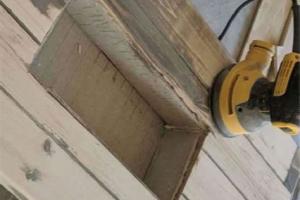Expert Guide: How to Effectively Remove Polyurethane from Your Surfaces

-
Quick Links:
- Introduction
- Understanding Polyurethane
- Why Remove Polyurethane?
- Tools and Materials Needed
- Step-by-Step Guide to Remove Polyurethane
- Safety Precautions
- Post-Removal Care
- Case Studies
- Expert Insights
- FAQs
Introduction
Polyurethane is a popular finish for wood surfaces, offering durability and water resistance. However, there are times when you may need to remove it—perhaps for refinishing or restoring furniture, or because it has become damaged. In this article, we’ll explore effective methods to remove polyurethane from various surfaces, ensuring you can achieve the best results without damaging the underlying material.
Understanding Polyurethane
Polyurethane is a synthetic polymer that is widely used as a protective finish on wood, floors, and furniture. It comes in two primary forms: oil-based and water-based. Understanding the type of polyurethane applied is crucial, as it influences the removal method.
Types of Polyurethane
- Oil-based Polyurethane: Takes longer to dry and typically requires mineral spirits for removal.
- Water-based Polyurethane: Dries faster and can often be removed with water and a mild detergent.
Why Remove Polyurethane?
There are several reasons you might want to remove polyurethane:
- Refinishing: Preparing surfaces for a new finish.
- Repair: Addressing damage or wear.
- Change of Style: Switching from glossy to matte finishes.
Tools and Materials Needed
Before starting the removal process, gather the necessary tools and materials:
- Polyurethane stripper (for oil or water-based finishes)
- Scraper or putty knife
- Steel wool or abrasive pads
- Paintbrush (for applying stripper)
- Protective gloves and goggles
- Drop cloths or plastic sheeting
- Ventilation fan (for safety)
Step-by-Step Guide to Remove Polyurethane
Step 1: Prepare the Area
Ensure the workspace is well-ventilated. Lay down drop cloths to protect surrounding areas from spills.
Step 2: Apply the Stripper
Using a brush, apply the polyurethane stripper generously over the surface. Follow the manufacturer's instructions for the recommended application thickness and wait time.
Step 3: Scrape Off the Polyurethane
Once the stripper has had time to work (usually 15-30 minutes), use a scraper or putty knife to gently peel away the loosened finish. Be careful not to gouge the wood beneath.
Step 4: Clean the Surface
After scraping, clean the surface with a damp cloth to remove any residue from the stripper. You may need to repeat the application if any polyurethane remains.
Step 5: Sand the Surface
For any stubborn spots, you can use steel wool or fine-grit sandpaper to remove residual finish. Be sure to sand in the direction of the wood grain.
Step 6: Final Clean Up
Once all polyurethane is removed, do a final wipe-down and let the surface dry completely before applying any new finish.
Safety Precautions
When working with chemical strippers, always take the following precautions:
- Wear protective gloves and goggles to guard against irritation.
- Work in a well-ventilated area to avoid inhaling fumes.
- Keep a fire extinguisher nearby when using flammable substances.
Post-Removal Care
After successfully removing polyurethane, consider the following:
- Inspect the wood for any damage that may require repair or sanding.
- Choose a suitable new finish that complements your project.
Case Studies
Here are a few real-world scenarios of polyurethane removal:
- Refinishing an Antique Table: An antique table was stripped of its worn polyurethane finish, revealing beautiful wood grain underneath, which was then stained and re-finished.
- Repairing Floor Damage: An oil-based polyurethane was removed from a hardwood floor to address scratches, allowing for a new coat of water-based finish to be applied.
Expert Insights
We spoke to woodworking expert Jane Doe, who emphasized the importance of patience during the removal process. "Rushing can lead to damage," she advises. "Always test your methods on a small, inconspicuous area first."
FAQs
1. How long does it take to remove polyurethane?
The time varies based on the thickness of the layers and the method used but typically ranges from a few hours to a full day.
2. Can I use vinegar to remove polyurethane?
Vinegar is not generally effective for removing polyurethane. It’s best to use a dedicated stripper.
3. Is it safe to remove polyurethane indoors?
It is not recommended to remove polyurethane indoors without proper ventilation due to fumes from chemical strippers.
4. What should I do if the stripper doesn’t work?
If the stripper fails, you may need to apply a second coat or switch to a more potent product.
5. How do I know if I have removed all the polyurethane?
Once all residue is gone, the surface should feel smooth and the wood grain should be visible.
6. Can I paint over polyurethane?
It is not advisable to paint over polyurethane without removing it first, as it will prevent proper adhesion.
7. What’s the best way to dispose of chemical strippers?
Follow local hazardous waste disposal guidelines for safe disposal of chemical strippers.
8. How can I prevent polyurethane from damaging my wood surface?
Always test finishes on a small area first and consider using protective pads under items placed on wood surfaces.
9. Can I use a heat gun to remove polyurethane?
Yes, but caution is required to avoid overheating and damaging the wood.
10. Is there a natural way to remove polyurethane?
Natural methods like using baking soda and water can work, but they are generally less effective than commercial strippers.
Random Reads